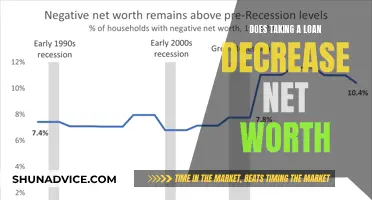
The Federal Reserve Bank of New York works to promote sound and well-functioning financial systems and markets by executing monetary policy, providing financial services, and supervising banks. The Fed's decisions on interest rates have a direct impact on various types of loans, including mortgages, credit cards, auto loans, and business loans. While the Fed does not directly provide loans, its monetary policies influence the interest rates and borrowing costs for consumers and businesses. The Fed's key interest rate, known as the federal funds rate, sets the rates for overnight lending between banks, which, in turn, affects the borrowing and savings rates that individuals and businesses encounter in their daily financial transactions.
| Characteristics | Values |
|---|---|
| Does the Fed provide loans? | No, the Fed does not provide loans. However, it influences the interest rates on loans. |
| Interest rates | The Fed held interest rates steady in March 2025. |
| Federal student loan rates | Fixed. Undergraduate students who took out direct federal student loans for the 2024-25 academic year are paying 6.53%, up from 5.50% in 2023-24. |
| Auto loan rates | Average rate on a five-year new car loan: 7.2% (as of the week ending March 14, 2025). |
| Student loan debt | Over 9 million student loan borrowers are expected to see their credit scores decrease as delinquencies hit record highs. |
What You'll Learn

The Fed's decision on interest rates
The Federal Reserve's decision to hold interest rates steady in March 2025 came after six straight months of declines. This decision was influenced by several factors, including economic uncertainty, inflation risks, and the impact of President Donald Trump's tariff policies.
The Federal Reserve's role is to influence the federal funds rate, which is the rate that banks charge each other for overnight lending. This rate has a significant impact on the borrowing and saving rates that Americans encounter in their daily lives. When the Fed hiked rates in 2022 and 2023, consumer borrowing costs quickly followed suit. However, the central bank began lowering its benchmark rate towards the end of 2024, and the Fed's decision in March 2025 to keep rates unchanged was influenced by this recent rate reduction.
Economic uncertainty, stemming from Trump's on-again, off-again tariff policies and rapid-fire layoffs of government workers, has caused a sharp drop in consumer confidence. This uncertainty is reflected in the Fed's beige book, which mentioned "uncertainty" 47 times in its latest edition, up from just 17 times in January. Many economists have lowered their estimates for economic growth, and there are concerns about a possible recession. As a result, the Fed is adopting a "wait-and-see" mode, keeping rates steady for now.
The impact of tariffs on inflation is another key consideration. While tariffs typically cause a one-time price increase, there are concerns that persistent inflation could result if tariff hikes become a series or if the increases are more significant. However, Fed Chair Powell noted that the economy remains mostly healthy, with solid job gains and a low unemployment rate of 4.1%.
The decision to hold interest rates steady has implications for various types of loans, including mortgages, auto loans, credit cards, and student loans. While fixed-rate mortgages and federal student loans are somewhat shielded from Fed moves, other types of loans, such as variable-rate private student loans, may be more directly impacted by changes in interest rates.
CFPB's Regulatory Scope: Private Trust Deed Loans
You may want to see also

How the Fed affects mortgage rates
The Federal Reserve influences mortgage rates, but it does not set them. The Fed's monetary policy is a factor in determining mortgage rates, along with other elements like the inflation rate, the pace of job creation, and the state of the economy. When the Federal Reserve adjusts the federal funds rate, it significantly impacts the broader economy, influencing borrowing costs, investment decisions, and overall economic activity, including mortgage rates.
The federal funds rate is the interest rate banks use when lending money to each other overnight to meet daily requirements. The Federal Open Market Committee decides it and it affects short-term interest rates for everyone. The Federal Reserve influences the fed funds rate by buying or selling government securities and adjusting the money supply to meet economic goals.
Mortgage rates typically follow suit when the Fed hikes rates, making home-buying less affordable and reducing refinancing activity. Higher rates also influence investment decisions by making financing more expensive, potentially slowing down capital expenditures and business expansion. However, higher rates can help control inflation by curbing excessive borrowing and spending, contributing to economic stability in the long term.
While fixed-rate mortgages are the most common in the US, some Americans prefer adjustable-rate mortgages (ARMs), which have variable interest rates that reset annually or semi-annually. The Fed’s moves can affect ARMs more directly. The rates on ARMs are often tied to the Secured Overnight Financing Rate (SOFR), which is based on the federal funds rate. Therefore, when the federal funds rate goes up, the ARM rate will also increase at the next adjustment.
Air Force Loan Repayment: What's the Current Status?
You may want to see also

The Federal Reserve's discount rate
The Federal Reserve's discount window offers different credit programs to financial institutions, with the main one being primary credit. Institutions that are in a generally sound financial condition are eligible for primary credit. This type of credit is a convenient and ready source of liquidity for banks. After signing up for the discount window and pledging collateral, the only additional information the borrower needs to provide when requesting an advance is the amount and term of the loan. Primary credit loans are available on an overnight basis or for a period of up to 90 days, and the interest rate on these loans adjusts if the primary credit rate changes during the loan tenure.
Secondary credit is available to institutions that do not qualify for primary credit, and it is offered at a higher interest rate. Additionally, seasonal credit is offered to small institutions to help them manage seasonal fluctuations in their balance sheets, with the rate for this type of credit being based on an average of selected market rates.
The Federal Reserve's actions regarding interest rates have significant implications for consumers. For example, when the Fed hiked rates in 2022 and 2023, most consumer borrowing costs, including credit card annual percentage rates, followed suit. Similarly, the Fed's decision to hold interest rates steady in March 2025 provided some relief to households, as certain consumer loan rates, such as auto loan rates, started to ease.
Tesla Loan Prepayment: Penalty or Peace of Mind?
You may want to see also

The Fed's role in student loan rates
The Fed, or the Federal Reserve System, is the central banking system of the United States. It plays a crucial role in influencing student loan rates, which are a significant concern for many Americans. The Fed's decisions on interest rates can have a variable impact on student loan borrowers, depending on whether they have federal or private loans.
Federal student loans have fixed interest rates, meaning that the interest rate remains constant throughout the life of the loan. Congress determines the interest rates for federal student loans annually, and these rates are valid from July 1 of the current year until June 30 of the following year. As a result, borrowers with existing federal student loans are generally shielded from the direct impact of Fed interest rate changes. For example, when the Federal Reserve decided to hold interest rates steady in March 2025, it did not affect the interest rates on existing federal student loans. However, those taking out new federal student loans after the Fed raises interest rates will face higher interest rates than those who borrowed previously.
On the other hand, private student loans often have variable interest rates tied to the prime rate, Treasury bill, or another rate index. Consequently, borrowers with private student loans may experience changes in their interest rates when the Federal Reserve raises or lowers rates. This dynamic is due to the federal funds rate influencing the borrowing costs of lenders, which are then passed on to consumers. Therefore, when the Fed raises interest rates, the average interest rate on private student loans also tends to increase over time, and vice versa when the Fed cuts interest rates.
The Fed's interest rate decisions can have significant implications for student loan borrowers. For instance, the New York Fed reported that student loan delinquencies were expected to reach record highs in the first quarter of 2025, affecting the credit scores of millions of borrowers. This situation arose partly due to the challenges posed by the COVID-19 pandemic, during which stimulus checks and payment pauses helped some borrowers reduce their balances, while others faced difficulties in resuming payments after the grace period ended.
Short Selling: TD Ameritrade's Stock Loan Policy Explained
You may want to see also

The Fed's response to economic uncertainty
The Federal Reserve plays a crucial role in shaping the economic landscape, particularly during periods of uncertainty. In the face of economic uncertainty, the Fed's response can be multifaceted, and its actions have a significant impact on businesses, consumers, and the overall financial climate.
One of the primary tools at the Fed's disposal is its ability to influence interest rates. By adjusting the federal funds rate, the Fed can impact the rates that banks charge each other for overnight lending, which, in turn, influences a wide range of borrowing and savings rates for consumers. For instance, during the COVID-19 pandemic, the Fed opted to reduce its key interest rate to mitigate the economic fallout, providing a reprieve for borrowers. However, keeping rates too low for too long can also lead to challenges, such as high inflation.
When economic uncertainty looms, the Fed must carefully consider its next steps regarding interest rates. In March 2025, the Federal Reserve decided to hold interest rates steady, opting for a wait-and-see approach amidst President Donald Trump's on-again-off-again tariff policies, which had caused a sharp drop in consumer confidence and heightened uncertainty among businesses. The Fed's decision to maintain interest rates was influenced by the potential for tariffs to spark persistent inflation, as well as the desire to avoid negative consequences for the housing market and consumer borrowing costs.
Another aspect of the Fed's response to economic uncertainty is its stance on student loans. The Federal Reserve Bank of New York highlighted the challenges faced by student loan borrowers, with delinquencies expected to climb to record highs following the pandemic. While the Fed itself does not provide loans, its policies can indirectly affect student loan borrowers. The Biden administration's plans for student loan forgiveness faced legal challenges, leaving borrowers in limbo. The Fed's actions, or lack thereof, in addressing student loan debt can have significant repercussions for millions of Americans.
In conclusion, the Fed's response to economic uncertainty involves a delicate balancing act. By adjusting interest rates, the Fed can influence borrowing costs and consumer spending. However, the Fed must also consider the potential for its actions to exacerbate inflationary pressures or create challenges in specific sectors, such as housing. Additionally, the Fed's role in addressing student loan debt and interpreting economic indicators further underscores its impact on the financial well-being of Americans during uncertain times.
The Fed's Lending Power: Individual Access Explored
You may want to see also
Frequently asked questions
No, the Fed does not provide loans. However, the Fed's decisions on interest rates can affect loans, credit cards, and bank accounts.
The Fed's interest rate decisions can influence the rates that banks charge their customers for loans. For example, when the Fed hiked rates in 2022 and 2023, most consumer borrowing costs quickly followed suit.
The Fed's manipulation of overnight interest rates charged to banks does not directly steer mortgage rates. Mortgage rates are influenced by the bond market, particularly the 10-year Treasury note. However, the Fed's interest rate decisions can impact the cost of borrowing for mortgages.







